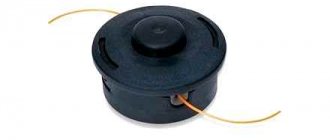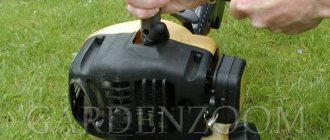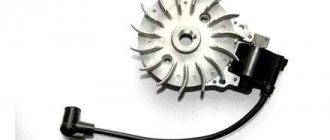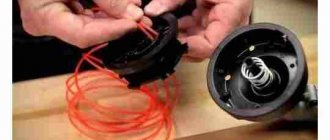Household and professional chainsaws are equipped with two-stroke internal combustion engines that are simple in design and reliable in operation. A significant proportion of drive failures occur due to fuel system malfunctions. Why does the spark plug on a chainsaw flood and how to fix this problem with your own hands?
The power units that make up the entire range of chainsaws operate on a precisely dosed mixture of fuel and special motor oil designed for the operation of two-stroke engines.
In the carburetor, fuel and air are mixed in a ratio of 1:16, after which the air-gasoline emulsion is supplied to the combustion chamber.
Consequences of running an engine with untuned fuel equipment
The traction characteristics of the engine and the duration of its service life depend on the composition of the mixture.
- Working on a lean mixture initiates a drop in power, overheating of the cylinder and intense wear of loaded parts and components of the chainsaw.
- Working with a rich mixture is no less dangerous. The malfunction is manifested by an increase in the time it takes to reach operating speeds, increased fuel consumption, and smoke from the muffler.
- There is also intense formation of carbon deposits in the combustion chamber and loss of mobility of the piston rings.
Shtil chainsaw does not start: reasons and solutions
First of all, it is worth noting the fact that chainsaw of this manufacturer is one of his best “creations”, but it also has its drawbacks. Actually, which we will talk about now.
- A fairly common problem is that chainsaw and the spark plug floods. The reason for this is that the oil that is poured in to lubricate the chain begins to leak. Since time is merciless and the seal is simply broken exactly in the place where the hose from the oil pump and the oil tank is actually connected. Naturally, this problem can be solved, but given the design of this chainsaw, this will not be so easy, since you simply have to completely disassemble the device in order, as they say, to get to the right place. The video shows it more clearly: https://www.YouTube.com/watch?v=UOsYJBOVuwg
- 180 chainsaw not start If you believe the experts, then in such a situation you need to first open and then close the cap located on the gas tank. Or take out and dry the candle. Or try to ventilate the combustion chamber. In most cases, this kind of manipulation is quite enough for the device to work. But there are times when the STIHL , but there is a spark...
- In the above case, you need to directly check the gasoline supply, the air filter and the immediate performance of the spark plug. Since the basis of this type of breakdown is the breather, namely its contamination. Because when it is completely clogged, a kind of vacuum appears in the gas tank itself, which simply interferes with the fuel supply process. Solving this issue is not difficult, since all you need to do is clean it using a needle.
- There are also situations when the device basically started up, but immediately stalled.
The main reasons for this type of malfunction are the carburetor and filter, which could simply be clogged.
In order to exclude the saloon from damaged objects, it is necessary first of all to disconnect the fuel hose from the carburetor itself and actually check whether fuel is leaking from it.
- You must remember that during proper operation of the chainsaw, gasoline must flow out in a dense and stable stream. It is also not uncommon for the STIHL 180 chainsaw to not start when hot and actually stalls after switching on, or holds power for a fairly short time. In this case, the problem of breakdown lies precisely in the muffler, which can simply be clogged with any deposits that arise due to the operation of the device , and which settle during the exhaust process.
- Also, a fairly common cause of tool malfunction is insufficient lubrication of the device chain itself. The reason for this may be channels that are simply clogged, or the reason is an oil line that is leaking.
- Connecting pipes or the connections themselves in the area of the oil pump fittings may also leak.
- It happens that the STIHL 180 chainsaw does not start well due to a cylinder that may be broken. But to determine its condition, a visual inspection is sufficient. But if there you find the formation of irregularities and chips, then you can be sure that you have found the cause of the breakdown.
- If, through checking, you find that the fault is in the spark plug, then you simply need to unscrew it and then dry it directly. But it is worth noting that under no circumstances should you pierce it, as you will simply ruin the part and it will be unusable. You also need to drain excess fuel from it through a special hole.
In addition, you must remember that direct drying should be carried out for at least thirty minutes, and only after this kind of manipulation can you install it back and actually try to start the tool directly.
The chainsaw won't start. Fills a candle. Repairing a saw with your own hands. #ViktorPolev
Moreover, it may also be that your candle has simply passed its expiration date, in which case it is necessary to replace it. Therefore, excellent advice is that it is best to always have a new candle in stock, or preferably a set. Then you can replace it at any time and actually understand whether it was the direct cause of the device failure. Moreover, the cause of the breakdown may also be a weak contact, which actually connects the high-voltage wire and the end of the spark plug. A faulty ignition unit may also be the cause. It is worth noting the fact that in order to eliminate this kind of problem, it is necessary to replace the unit itself since it cannot be repaired.
READ Dilute Gasoline with Husqvarna Chainsaw Oil
Calm, fills the spark plug Adjusting the carburetor Viktor Polev
But it is worth noting that it would be best if it is repaired by specialists, since if you have the necessary knowledge and skills, then you can simply break it and have to buy a new one.
Algorithm for determining the causes of poor mixture formation
In any case, a wet spark plug on a chainsaw indicates a clear imbalance in the composition of the air-fuel emulsion. Already at a fuel to air ratio of 1:14, the conditions for spark formation worsen; the lack of air prevents the normal combustion of the fuel-air emulsion compressed in the combustion chamber.
The main reasons for over-enrichment of the mixture in most cases are standard:
- air intake filter clogged;
- incorrect carburetor adjustment;
- interruptions in the operation of the ignition system;
- It is also possible that the quality of gasoline is poor and that the starting sequence of the power unit is not correct.
Fuel and air filters - checking their serviceability
If the fuel or air filter is clogged, the chainsaw will also not be able to start. First you need to check the serviceability of the air filter, which is located in a plastic housing. The air filter of a chainsaw gets clogged very often, so it is recommended to clean it before use. To clean, you will need to use a compressor. If the air filter on a chainsaw is clogged with sawdust and shavings, the engine will not start when hot.
Air does not enter the carburetor, so only an excess amount of fuel is supplied to the cylinder, which causes the spark plug to flood.
The case of a clogged air filter on a chainsaw is very interesting. If it is clogged, then the chainsaw usually starts when cold, but as soon as the air damper opens to supply air, the engine immediately stalls after warming up. When hot, a chainsaw with a clogged filter will not start at all, or it will start and immediately stall. When diagnosing the air filter, you need to pay attention to the damper, through which the air supply is limited.
Make sure that the damper moves freely when you operate the lever to close and open it.
- If the valve does not close, then an attempt to start the chainsaw when cold is unsuccessful.
- A similar situation occurs when the chainsaw is running hot. If the engine starts when cold, but stalls when warmed up, this may be due to the fact that the throttle is stuck in the closed position.
As you can see, not only the starting of the chainsaw engine, but also its proper operation depends on the serviceability of the air filter and damper.
Risks of using low-quality fuel
Various low-octane gasolines and fuel substitutes contain alcohol components, which require more time for complete combustion. The profitability of using such fuel is questionable, since there are a number of factors confirming ineffective operation and increased engine wear.
The oiling of the spark plug is facilitated by the use of heat-resistant motor oils for 4-stroke engines, high wear of the compression rings or the entire piston group as a whole.
Why is primary adjustment needed?
Initial running-in of a chainsaw: working with thin material
Most modern chainsaws go on sale adjusted. However, it doesn’t hurt to check the quality of the factory settings - in the end, it’s you who will have to work with the tool.
When starting up for the first time, the chainsaw should operate in a gentle mode. Therefore, for several hours after start, it is recommended not to overload the engine and cut only small branches and trunks up to 10 cm thick.
Simple rules will help you insure against malfunctions of the chainsaw carburetor:
- Always mix gasoline and oil according to the manufacturer's instructions.
Proportions of the fuel mixture for a chainsaw engine - Do not prepare the fuel mixture in advance - the properties of gasoline and oil in a mixed state are lost over time. The exception is fuel for intensively used tools, however, even here the norm should not exceed approximately a week.
- Use oil designed for your chainsaw engine. A fuel mixture with a non-standard composition will seriously and permanently disable it.
- When preparing the fuel mixture, take into account the influence of climatic conditions on its components.
The chainsaw must start correctly, ensure a stable rotation speed of the sprocket and a smooth increase/decrease in power. There should be no extraneous knocks, pops or noises when the engine is running.
Professional hand chainsaw at work
The main thing during the initial running-in of the tool is to ensure that the fuel consumption corresponds to the power used, i.e. in practice, the saw should not go out, “sneeze”, smoke or run jerkily.
Troubleshooting Tips
In the first case, the problem is solved by bringing the air intake device into working order. It is recommended to blow out an exhausted paper filter with a reverse air flow or, at best, replace it. Refer to the supplied instruction manuals for cleaning methods for other types of filters.
- The carburetor is adjusted with the engine warmed up to operating temperature. The power unit is brought to optimal mode by rotating the adjusting screws for the quantity and quality of the mixture. The success of the work is determined by knowledge of the design of the fuel supply system and the interaction of all components.
- In particular, the increased complexity of adjusting carburetors with built-in compensators and other automatic control elements. Such equipment is configured using special equipment that is supplied to service and repair centers.
If the engine cannot be tuned, the cause of excess fuel in the emulsion may be a leak in the valve or a stuck carburetor float itself.
The final result of the work performed:
- fast acceleration;
- stable operation at idle;
- restoration of traction parameters;
- absence of increased smoke and detonation noise.
Why does the gas cutter stall when you give it gas?
There may be even more reasons for this than in previous cases. Let's look at the main ones.
- Low quality fuel or oil, as well as incorrect calculation of the volumetric parts of the mixture required by the user manual;
- Unexpected flooding of spark plugs with fuel after starting at idle speed. To resume operation, excess fuel is drained, the spark plug is removed from the device and dried. Only after this can the unit start again;
- Also, the chainsaw starts normally, but when adding gas it stalls due to the fact that the spark may disappear. This usually happens when there is a weak connection between the wire and the spark plug tip or there are significant defects in the ignition elements.
- There is not enough fuel for the normal functioning of the chainsaw or its supply is insufficient (the air filter or breather is clogged with dust particles).
- The muffler is “overgrown” with pollutants and requires urgent cleaning.
- Problems in the cylinder-piston system.
- Problem with the lubrication system. It may simply not be enough, or the oil filter and conductive tubes may be clogged with debris. They wear out very much, so every time before you start working with a gas-powered tool, you should check it for the integrity of the tubes and connections supplying lubricant.
Criteria for the selection and operation of spark plugs
The simplest indicator of mixture quality is the porcelain insulator of the spark plug center electrode. Any shade of brown indicates normal quality of the mixture; white or sooty insulator indicates a poor or over-enriched emulsion composition.
The heat rating of the spark plug in use must meet the stated requirements.
- The cause of oiling may be a so-called “cold” spark plug, which can be visually identified by a short insulator. Interruptions in sparking are possible if the gap is adjusted incorrectly or due to natural contact burnout.
- The recommended distance between the spark plug contacts is indicated in the instructions; in the absence of information, you can focus on the standard value of 0.7-1 mm. With a smaller gap, the efficiency of ignition of the fuel-air emulsion decreases; with an increased gap, interruptions in spark formation are possible.
- It is not recommended to burn a damp or oily candle on an open flame due to the risk of cracks and premature failure.
Over-enrichment of the mixture in the combustion chamber of a technically sound chainsaw is eliminated by purging the engine. To do this, just remove the spark plug and crank the crankshaft several times with a manual starter.
What to do if the spark plug is flooded on the chainsaw
If you suspect a flooded spark plug, you need to inspect it. Using a spark plug wrench, it is unscrewed and carefully examined. If the spark plug is wet, but there is a spark, then it has definitely been flooded.
Read also: Mold on the ground in seedlings
Many experienced owners are able to determine with a high degree of probability the current condition of a candle by its color. It is recommended to carry out this procedure regularly.
- Light brown soot is exactly what all owners want to see. In this case, the functionality of the chainsaw is not impaired.
- Black carbon deposits indicate an unbalanced mixture, namely a lack of oxygen in the fuel chamber. If the situation does not improve, there is a high probability that the chainsaw spark plug will flood again.
- If corrosion is detected on the fork or the distance between the electrodes is too large, then most likely a lean fuel mixture is used.
DIY walk-behind tractor repair
Unfortunately, any equipment sometimes breaks down, so its owner needs to be able to troubleshoot problems on his own. Of course, if the car is under warranty, it is better to take it to a service center, where specialists will carry out warranty repairs free of charge.
Often, damage to a cultivator or walk-behind tractor occurs due to improper operation - when bad fuel is poured, heavy loads are allowed, or losses of lubricant are not replenished during time. Then the car begins to stall, stall, pick up speed poorly (especially if it has an electric motor), or even stops starting altogether. But, knowing the structure of the unit and the operating principle of its mechanisms, you can identify the cause of the damage yourself and carry out quality repairs.
Fuel system repair
A breakdown of the fuel system can be confirmed if the engine:
- does not start;
- stalls under load;
- does not function stably at idle speed.
To eliminate the malfunction, first check the condition of all filters, including air and oil. If they are slightly clogged, they are blown with compressed air or washed; if they are heavily contaminated, they are replaced with new ones. Then the carburetor is disassembled, the parts are washed with a special cleaner, and the fuel mixture supply valve, tank and piston system are cleaned with gasoline. After drying, carefully carry out the reverse installation.
After the engine is completely assembled, the crankshaft is cranked by hand - it is important that the piston moves freely and the valves work flawlessly. Then pour in fresh lubricant, start the engine and leave it to idle. Be sure to check the flow of fuel into the cylinder. Perhaps, after such repairs, the cause of the malfunction will be eliminated and the walk-behind tractor will begin to function without interruption.
Ignition system repair
You can judge the breakdown of devices for igniting fuel assemblies by the signs when the engine:
- starts, but stalls at idle;
- does not start even with good fuel supply;
- It works at idle, but with some interruptions.
To find out the reason, first check the condition of the spark plugs: if there is damage to the insulator, replace them. Next, inspect the electrodes and, if necessary, adjust the gap between them. The condition of high-voltage wires is checked for oxidation of the tips and damage to the insulation - damaged wires must be replaced with new ones. Without such repairs, the spark may completely disappear or will travel through the insulation, breaking through to the engine body, and will not be able to ignite the fuel assembly.
If at this stage no defect with a spark is detected, then perhaps the reason that the equipment does not start or stalls lies in the generator or coil (for models such as Neva, Cascade, it serves to generate a spark). To check the generator, a measuring device is connected to its terminals. Scroll the starter pulley of the walk-behind tractor and record the readings of the device - they should be in the range of 12-16 W. If the indicators are normal, then the reason is in the ignition coil and after replacing it, you can put a load on the engine. Most likely, after such repairs, its functionality will resume completely.
Transmission repair
The following factors indicate a transmission malfunction:
- the working shaft is motionless, and the output shaft rotates;
- engine speed does not correspond to the working shaft speed;
- the engine seems to be “choking” under the load.
If at least one of the listed reasons appears, immediately check the presence of lubricant in the gearbox. The lubricant in it must be normal, since lubricant prevents “dry” friction of moving parts and prevents them from overheating.
Then the gearbox is disassembled, the gears are inspected, and the chain tension is checked. Whole parts are washed in kerosene, and damaged parts are replaced with new ones. After this, the structure is assembled and care is taken to prevent the gears from misaligning.
Before the assembled gearbox is installed on the walk-behind tractor, the shafts are rotated to make sure that they rotate evenly and without the slightest grinding noise. The gearbox is filled with fresh lubricant and the cultivator is started. If there are no leaks under the body, perform simple actions with a rototiller or mounted loader and check the functionality of the walk-behind tractor. If its functionality is restored, it means that all efforts were not in vain, and repairs and maintenance were carried out correctly.
Reanimation of a walk-behind tractor after winter and the most common failures of walk-behind tractors.
I tried to start the walk-behind tractor after winter, but the walk-behind tractor would not start. How to start a walk-behind tractor if it does not start can only be guessed at the beginning, because there may be several reasons:
— wire break; — there is not enough gasoline in the tank and it is not absorbed; — the spark plug is dirty.
Do I need to adjust the carburetor?
Many consumers do not consider chainsaws to be innovative equipment used only by specialists. Many summer residents and ordinary home craftsmen have such a tool. After all, a chainsaw is used as a convenient replacement for an axe, especially since manufacturers offer customers a variety of models of units at a very affordable price.
Since the design of the device is quite simple, if desired, anyone can figure out why the chainsaw does not start, taking into account the advice of experts. Before we begin to consider the main issue, you should figure out how to adjust the carburetor - the main cranking device of chainsaws
If we consider the adjustment on the popular Shtil 180 model, then such an event is simply impossible to carry out
Before we begin to consider the main issue, you should figure out how to adjust the carburetor - the main cranking device of chainsaws. If we consider the adjustment on the popular Shtil 180 model, then such an event is simply impossible to carry out.
In this model, the carburetor is equipped with a single adjustment screw, that is, the crank can be considered as a screw used to adjust the idle speed. The jet provided in the factory device is stationary and fully equipped with a load. In simple words, we can say that the factory setting of the carburetor helps to supply the air-fuel mixture directly to the engine during operation of the unit.
Features of the Chinese chainsaw carburetor
Their design and parameters differ depending on the power and model of chainsaw they are intended for. All of them are almost identical to the original carburetors in design, but not always in quality. Today, all Chinese products cannot be considered 100% rubbish. In turn, according to their quality, they can be divided into three groups:
- Poor quality. Unsuitable alloys are used which oxidize, crumble and break. There is no accuracy of fit, the calibrated holes do not correspond to the required values, which leads to excessive consumption or lack of fuel in the combustion chamber. Critical parts quickly fail. Plastic parts quickly become rough or, conversely, become softened by gasoline and stop working. The axles and wire rods are bent, the threads of the fasteners are torn off. Such products are the cheapest. They are made in semi-handicraft industries using adapted equipment. As a rule, they do not have a name or marking.
- Carburetors are of average quality. These are factory assembled products. They do not skimp on alloys; they have established continuous production with quality control. These are fully functional carburetors that can have a service life even longer than that of the entire chainsaw.
- High quality carburetors. First of all, these are products from global manufacturers whose facilities are located in China. Geographically, they can be considered Chinese, but they are made using the technologies of the company that owns the brand and values its reputation. For example, Japanese Walbro carburetors are produced in China.
In addition, among Chinese manufacturers there are those who rely on high quality. They invest heavily in powerful production facilities, register their own brand and work on its reputation.
Carrying out disassembly
Read:
If you are adjusting the carburetor of the Partner-350 chainsaw, then you should become more thoroughly familiar with the design of the unit; in almost all models, the design features are practically the same, so the advice given will be vital.
The elements need to be removed with the greatest care, placing them in order; this will help you during the assembly process. Three bolts hold the top cover, they need to be removed, then you will see a layer of foam rubber, which acts as an integral part of the air filter. The technician will have to get rid of the fuel hose, this will allow the drive rod to be removed.
Adjusting the carburetor of the Partner-350 chainsaw is impossible unless the cable tip is removed; this should be done in the next step. The gasoline hose, which is located to the left of the fitting, will need to be removed. All of the above work will allow you to disconnect the carburetor , which can be adjusted. This mechanism is complex, so if further disassembly is necessary, you need to remove the elements carefully, because their size is very small, which is why they can easily get lost.
Starting gasoline and diesel units
The walk-behind tractor is a multifunctional tool. It is indispensable for running a household plot. Attachments allow you to perform land cultivation, grass mowing, snow removal, cargo transportation, planting and harvesting.
The equipment is equipped with gasoline or diesel engines. There are differences between starting a diesel walk-behind tractor and a gasoline unit. Therefore, the reasons why the walk-behind tractor does not start should be analyzed for each specific engine type.
Before starting the walk-behind tractor, the equipment is prepared. You need to make sure that all parts are present and that the mechanisms are securely fastened.
Mechanisms often stop working after winter. A long break causes malfunction of the walk-behind tractor systems. Storage in a cold and damp room leads to the following damage:
- Oxidation of contacts.
- Violation of wire insulation.
- Watering of fuel and oil.
- Carburetor jets clogged.
Before starting a new walk-behind tractor, all connections, clutch cable, reverse and throttle are checked. The movement of the cables should be smooth and effortless. Do not start the unit if there are clamps and twists in the harness threads.
During the first start, be sure to check the oil level in the crankcase. Lack of lubrication will damage the piston group. The crankshaft rotates up to 1400 rpm at idle. A couple of seconds is enough for a scuff to form on the surface of the cylinder.
Old oil can cause engine failure. At the same time, the walk-behind tractor smokes white exhaust gases. A complete oil change suggests itself.
It should be taken into account that the walk-behind tractor does not start well if there is insufficient oil volume. Keep an eye on this parameter before starting a carburetor and diesel walk-behind tractor. On some models, protection is set to a low level. The sensor blocks the start and the unit stalls.
It should be remembered that each type of engine requires a certain brand of gasoline. For a two-stroke engine, fuel is prepared separately. The fuel mixture consists of gasoline and oil. The amount of ingredients is kept in strict proportions.
Purchase gasoline for walk-behind tractors at gas stations. The service life of vehicles directly depends on the quality of fuel. You should not start the walk-behind tractor on bad gasoline.











